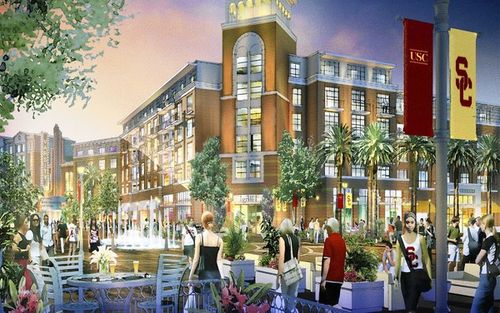Kristina Raspe, Vice President of Real Estate and Asset Management at USC, explained in an interview with NPR that over the years, as the college has grown, the college has changed from a commuter campus to one where the majority of students live within a 1 mile radius. This has resulted in rising rent, the displacement of local residents, and the illegal conversion of single family homes into multi-family units. Once the new dorms are completed, USC predicts that upwards of 900 units will be given back to the community. USC set up a fund to return these properties into single family homes in order to give them back to the community. Raspe explains, “Our goal is to free up more community housing… We just want to house the students that are already in the neighborhood in University housing that is appropriate for student housing.”
The University Village will also be expanded. There are rumors of Trader Joes, Forever 21, Banana Republic and other college friendly retailers being added to the multi-story shopping center. Raspe maintains that the small businesses currently in University Village have been invited to come back once construction is complete. Rent may be higher, but that could potentially be offset by a higher volume of collegiate consumers attracted to the renovated shopping center.
As it currently stands, some students have gone so far as to call the current University Village an eyesore. Originally built from funds from a non-profit community redevelopment agency, the shops currently in the Village service the needs of the local population far more than those of the students. Regardless, the center suffers from faded and chipped paint and many vacant storefronts.
USC projects that the University Village project will create over 9,000 jobs, many of which are permanent.
At a recent community meeting about the expansion, over 600 people showed up to participate in the discussion. Although the majority showed support for the new developments, some members of the community are not happy.
One organization in particular, SAJE, or Strategic Actions for a Just Economy, feels that USC’s expansion will only continue the displacement and gentrification the community has seen over the past 50 years. According to their website, SAJE partners with underrepresented members of the community in order to “make sure the fate of city neighborhoods is decided by those who live there.”
Although Raspe maintains that the current businesses in the Village have been invited back, SAJE counters that there is no contract or guarantee to back those claims. In addition, there is uncertainty about whether or not these small business owners will be able to afford the new rent, which will be opened up at market value. The new retailers that have shown interest in the area are not necessarily ones that service the needs of the local community.
SAJE also claims that the influx of USC students has driven up housing prices over the years, resulting in the displacement of families. The students themselves seem to agree with this. One student writes on the Daily Trojan’s online thread regarding apartment high rises in the area that, “[The} two developments are literally right across the street from campus and they charge us a huge amount of money to rent… Management is extremely poor. [It’s] ridiculous.”
So, although USC plans to give about 900 homes back to the community, SAJE Executive Director Paulina Gonzalez doubts the locals will be able to afford housing at the current market rate. The current annual income of the majority of families living around the USC area is under $35,000 where as the rental rate is about $1,500 a month. According to Gonzalez, one would need to make about $60,000 a year to make those units affordable.
Adding insult to injury, although USC did consult the city about their building plans. “The community was never at the table during this process,” Gozalez states.
SAJE is asking for USC to sign a contract with local businesses, build new low income housing in the community, and guarantee that a sizable portion of the new jobs created go to local residents.
“The University has a responsibility to make the community whole,” says Gonzalez.
Across the United States many other colleges are struggling with similar problems. When they need to expand to fit the needs of their students, they often find that those needs are not necessarily congruent with the needs of the community. John Hopkins University in Baltimore, Maryland, or University of Pennsylvania in Philadelphia, Pennsylvania are perfect examples of this.
Unlike other local universities in Southern California like LMU or UCLA, the community around USC varies vastly in socioeconomic status than that of the student body.
What do you think? Is it USC’s responsibility to provide affordable real estate to the community or is change and gentrification simply the result of a free market economy?








